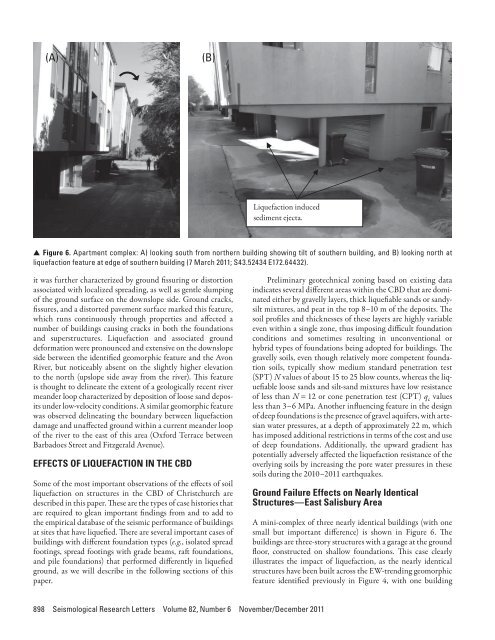Here - Stuff
Here - Stuff
Here - Stuff
Create successful ePaper yourself
Turn your PDF publications into a flip-book with our unique Google optimized e-Paper software.
(A)(B)Liquefaction inducedsediment ejecta.▲ ▲ Figure 6. Apartment complex: A) looking south from northern building showing tilt of southern building, and B) looking north atliquefaction feature at edge of southern building (7 March 2011; S43.52434 E172.64432).it was further characterized by ground fissuring or distortionassociated with localized spreading, as well as gentle slumpingof the ground surface on the downslope side. Ground cracks,fissures, and a distorted pavement surface marked this feature,which runs continuously through properties and affected anumber of buildings causing cracks in both the foundationsand superstructures. Liquefaction and associated grounddeformation were pronounced and extensive on the downslopeside between the identified geomorphic feature and the AvonRiver, but noticeably absent on the slightly higher elevationto the north (upslope side away from the river). This featureis thought to delineate the extent of a geologically recent rivermeander loop characterized by deposition of loose sand depositsunder low-velocity conditions. A similar geomorphic featurewas observed delineating the boundary between liquefactiondamage and unaffected ground within a current meander loopof the river to the east of this area (Oxford Terrace betweenBarbadoes Street and Fitzgerald Avenue).EFFECTS OF LIQUEFACTION IN THE CBDSome of the most important observations of the effects of soilliquefaction on structures in the CBD of Christchurch aredescribed in this paper. These are the types of case histories thatare required to glean important findings from and to add tothe empirical database of the seismic performance of buildingsat sites that have liquefied. There are several important cases ofbuildings with different foundation types (e.g., isolated spreadfootings, spread footings with grade beams, raft foundations,and pile foundations) that performed differently in liquefiedground, as we will describe in the following sections of thispaper.Preliminary geotechnical zoning based on existing dataindicates several different areas within the CBD that are dominatedeither by gravelly layers, thick liquefiable sands or sandysiltmixtures, and peat in the top 8–10 m of the deposits. Thesoil profiles and thicknesses of these layers are highly variableeven within a single zone, thus imposing difficult foundationconditions and sometimes resulting in unconventional orhybrid types of foundations being adopted for buildings. Thegravelly soils, even though relatively more competent foundationsoils, typically show medium standard penetration test(SPT) N values of about 15 to 25 blow counts, whereas the liquefiableloose sands and silt-sand mixtures have low resistanceof less than N = 12 or cone penetration test (CPT) q c valuesless than 3–6 MPa. Another influencing feature in the designof deep foundations is the presence of gravel aquifers, with artesianwater pressures, at a depth of approximately 22 m, whichhas imposed additional restrictions in terms of the cost and useof deep foundations. Additionally, the upward gradient haspotentially adversely affected the liquefaction resistance of theoverlying soils by increasing the pore water pressures in thesesoils during the 2010–2011 earthquakes.Ground Failure Effects on Nearly IdenticalStructures—East Salisbury AreaA mini-complex of three nearly identical buildings (with onesmall but important difference) is shown in Figure 6. Thebuildings are three-story structures with a garage at the groundfloor, constructed on shallow foundations. This case clearlyillustrates the impact of liquefaction, as the nearly identicalstructures have been built across the EW-trending geomorphicfeature identified previously in Figure 4, with one building898 Seismological Research Letters Volume 82, Number 6 November/December 2011
















